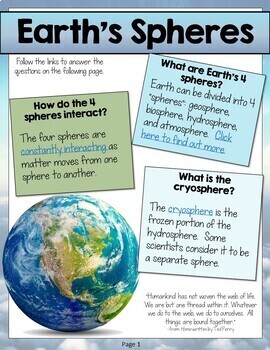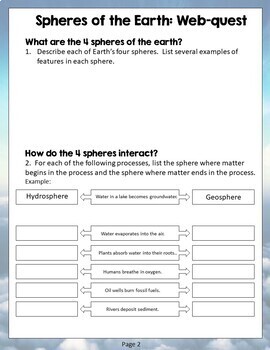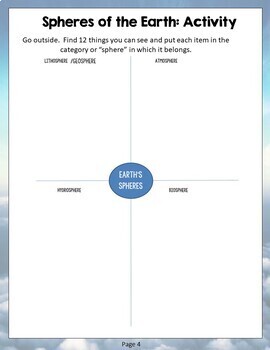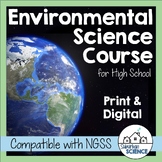Earth's Systems - Biosphere, Hydrosphere, Atmosphere, Geosphere, Cryosphere
- Zip
- Internet Activities
Also included in
- These environmental lesson plans will help your students to take charge of their learning! This comprehensive course is interactive, hands-on, and student-centered! Students learn about major environmental issues in modern society through detailed lessons and activities. Units cover the four sphePrice $250.00Original Price $276.00Save $26.00
Description
This environmental science lesson and activity is a quick and easy introduction to the earth's spheres: geosphere, hydrosphere, biosphere, and atmosphere. A brief introduction to the cryosphere is also included.
____________________________________________________________________
➤➤This lesson is the starting point for my Environmental Science course that delves into deeper content in each of the earth's spheres. It includes PowerPoint presentations, guided Cornell notes, webquests, labs and activities, doodle notes, and assessments.
____________________________________________________________________
➤Included in this product:
- Detailed teacher lesson plan including essential questions, standards, included resources, and materials list
- Student web-quest on biosphere, atmosphere, hydrosphere, and lithosphere as well as interactions between them
- A short exploration of the cryosphere and its significance in climate change studies
- An outdoor activity in which students examine local ecology
- A concept map to practice vocabulary
➤How do I use this lesson?
Students independently gain vocabulary and basic concepts through internet web-quests and videos. The content delivery is perfect for substitutes because students can work independently on the web-quest and research project.
➤What curriculum could I use with this lesson?
This lesson is ideally geared toward high school students and would work well with a general-level Environmental Science or Biology textbook. It is not designed to meet AP Environmental Science or AP Biology standards but could supplement these courses.
➤Are you interested in other Environmental Science topics? Here are my other Environmental Science lessons:
- Introduction to Env Science- Ethics, Scientific Processes, and Environmental Policies
- Biosphere Unit 1- Ecology, Food Webs, and Symbiosis
- Biosphere Unit 2- Species and Population Ecology
- Biosphere Unit 3- World Biomes, Ecological Succession, and Biodiversity
- Atmosphere- Global Weather and Biogeochemical Cycles
- Geosphere Unit 1- Plate Tectonics and Landforms
- Geosphere Unit 2- Minerals, Mining, and Soil
- Geosphere Unit 3- Fossil Fuels and Renewable Energy
- Hydrosphere Unit 1- Water Cycle, Surface Water & Groundwater
- Hydrosphere Unit 2- Marine Biomes and Water Pollution
- Human Impact: Land Use, Urbanization, and Sustainability
________________________________________________________________________
⭐For updates about sales and new products, please follow my store: My TpT Store
You can also
⭐Subscribe to my newsletter for freebies and teaching tips
⭐Follow me on Instagram
⭐Check out my Facebook page
⭐Follow me on Pinterest
I value your feedback. Please rate this product. If you have any issues or questions about this product, please feel free to ask a question in my store or write to me at support@suburbanscience.com.






